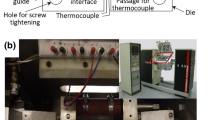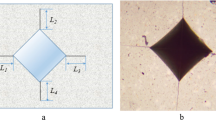Abstract
A study was made of the structure and mechanical properties of WC ― Co cemented carbides alloyed with Ru, Re, and Os. It was shown that the alloying elements form solid solutions with the binder phase, Co(Ru, W, C), Co(Re, W, C), Co(Os, W, C), which have higher microhardnesses and elastic moduli than the solid solution Co(W, C). Ruthenium, rhenium, and osmium reduce the stacking fault energy of the cobalt phase and promote the transformation of the cubic modification of cobalt to the hexagonal. This results in precipitation hardening of the binder phase. Additions of Ru, Re, and Os increase the hardness, and bend, compression and yield strengths, of WC ― Co alloys. Examples of the successful use of WC ― Co cemented carbide tools alloyed with noble metals for the machining of heat-resistant alloys and high-alloy steels are given.
Similar content being viewed by others
REFERENCES
A. Mynard, B. Jones, V. A. Tracy, and W. Betteridge, “Cutting tools and cutting processes,” Pat. 1393115 England, Publ. 07.05.75.
G. F. Karasev, Z. N. Sapronova, and I. M. Stukalov, “Cutting properties of WC-based alloys with a cobalt-rhenium binder,” in: Hard Alloys and Tools [in Russian], Nauch. Tr. VNIITS, Metallurgiya, Moscow (1986), pp. 61-63.
A. E. Bik, Z. N. Sapronova, V. A. Chistyakova, and M. S. Yantovskaya, “Efficacy of new grades of hard alloys in the machining of tungsten,” in: Hard Alloys and Tools [in Russian], Nauch. Tr. VNIITS, Metallurgiya, Moscow (1986), pp. 68-71.
I. N. Chaporova, V. I. Kudryavtseva, and Z. N. Sapronova, “WC-based alloy with a cobalt-rhenium binder,” A.s. 616814 SSSR, Otkr., Izobret. (1982), No. 15.
A. M. Gulan and E. E. Timm, “Rhenium-bound tungsten carbide composites,” Pat. 92/01355 PCT/US, Publ.02.09.93.
I. N. Chaporova, Z. N. Sapronova, and V. I. Kudryavtseva, “Investigation of phase equilibria in the WC — Re — Co system at 1570 K,” in: Phase Diagrams of Metallic Systems [in Russian], Sb. IV Vsesoyuz. Soveshch., Nauka, Moscow (1982), pp. 114-115.
I. N. Chaporova, L. M. Yupko, Z. N. Sapronova, and V. I. Kudryavtseva, “Construction of the polythermic section Re, Co — WC in the W — C — Re — Co system by the method of differential thermal analysis,” in: IX Vsesoyusnoe Soveshchanie po Termicheskomu Analizu, Kiev (1985), p. 145.
I. N. Chaporova, V. I. Kudryavtseva, and Z. N. Sapronova, “Investigation of the structure and properties of alloys in the WC — Re — Co system,” in: Quality and Efficacy of Use of Hard Alloys [in Russian], Nauchn. Tr. VNIITS, Metallurgiya, Moscow (1984), pp. 7-10.
I. N. Chaporova, É. I. Repina, Z. N. Sapronova, and V. I. Kudryavtseva, “Structure and properties of sintered hard alloys,” Metalloved. Term. Obrab. Met., No. 2, 52-55 (1984).
A. F. Lisovskii and N. V. Tkachenko, “Creation of graded structures in sintered hard alloys,” Sverkhtverd. Mater., No. 1, 27-34 (1995).
A. S. Lisovskii, Migration of Liquid Metals in Sintered Composite Bodies [in Russian], Nauk. Dumka, Kiev (1982).
A. F. Lisovsky and N. V. Tkachenko, “Composition and structure of cemented carbides produced by the MMI process,” Powder Met. Int., 23, No. 3, 157-161 (1991).
A. F. Lisovsky, T. E. Gracheva, and V. N. Kulakovsky, “Composition and properties of (Ti, W)C — WC — Co sintered carbides alloyed by the MMI process,” Int. J. Refractory Metals and Hard Materials, 13, 379-383 (1995).
A. F. Lisovsky and N. V. Tkachenko, “On the use of the MMI phenomenon for the formation of nanostructures in WC — Co cemented carbides,” Int. J. Refractory Metals and Hard Materials, 15, 227-235 (1997).
K. S. Chernyavskii, “Stereological properties of heterogeneous materials,” Poroshk. Metall., No. 1, 81-86 (1985).
A. A. Lebedev and É. V. Chechin, “On the selection of allowable stresses in structural calculations using the criterion of statistical strength,” Probl. Prochnosti, No. 4, 32-34 (1980).
A. F. Lisovsky, V. N. Tkachenko, and V. Kebko, “Structure of binding phase in Re-alloyed Wc — Co cemented carbides,” Int. J. Refractory Metals and Hard Materials, 10, No. 1, 33-36 (1991).
C. N. Vasel, A. D. Krawitz, et al., “Binder deformation in WC — (Co, Ni) cemented carbide composites,” Met. Trans. A, 16A, 2309-2327 (1985).
I. N. Chaporova, Z. N. Sapronova, and L. M. Yupko, “Thermal analysis of alloys in the W — C — Re — Co system,” in: Investigation of the Properties of Hard Alloys and Questions of Their Use [in Russian], Nauchn. Tr. VNIITS, Metallurgiya, Moscow (1989), pp. 6-9.
H. G. Schmid, D. Mari, W. Benoit, and C. Bonjour, “The mechanical behavior of cemented carbides at high temperatures,” Mater. Sci. Eng. A, 106, No. 1-2, 343-351 (1988).
S. S. Ordan'yan, I. V. Panteleev, and T. V. Lukashova, “Hard alloy tool based on tungsten carbide with a Co — Ni — Re binder,” Tsvet. Metally, No. 9, 62-65 (1997).
Author information
Authors and Affiliations
Rights and permissions
About this article
Cite this article
Lisovskii, A.F. Cemented Carbides Alloyed with Ruthenium, Osmium, and Rhenium. Powder Metallurgy and Metal Ceramics 39, 428–433 (2000). https://doi.org/10.1023/A:1011306204246
Issue Date:
DOI: https://doi.org/10.1023/A:1011306204246




